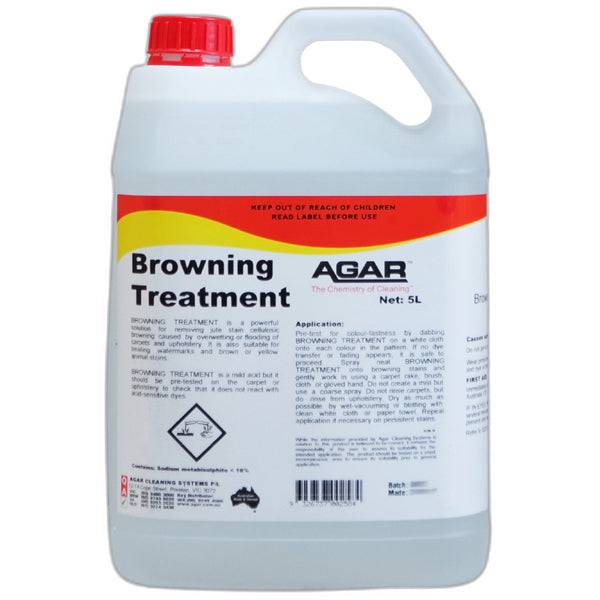
Item added to your cart


Odour: Sulphur odour.
BROWNING TREATMENT is a powerful liquid treatment for removing jute stain cellulosic browning caused by over wetting or flooding of carpets and upholstery.
How Does It Work?
When a cellulosic fibre such as jute, cotton or linen is wet with water and allowed to dry very slowly, a brown discolouration often appears at the point where the evaporation of the moisture takes place. This brown colour is known as cellulosic browning. It results from the degradation of cellulose and is a similar discolouration to the yellowing that occurs as a newspaper yellow with age. Most carpets contain one or more cellulosic fibres. For example, in tufted carpets jute is used as the primary or secondary backing. Some rugs are made entirely of cotton. Consequently, when these carpets or rugs are cleaned by shampooing or by hot water extraction, they may develop browning when they dry because the moisture may carry brown cellulosic matter up onto the fibres.
When does browning occur?
Browning can only occur if three factors are present: 1. A cellulosic fibre, 2. Moisture, and 3. Slow drying. If the water used to clean the carpet comes into contact with cellulosic fibres (eg. in the jute backing) then a small portion of cellulosic material may dissolve and be carried up the tufts by a wicking process as the carpet dries. As the last of the water evaporates, the tips of the tufts may become badly discoloured with brown stains. The slower the drying, the more browning that will occur. This is because the moisture evaporates from the tips of the tufts and the brown discolouration is carried right to the top of the carpet. Over-wetting a carpet increases the risk of browning. On the other hand, if the carpet is dried quickly, then the tips of the tufts dry out first and browning is prevented from rising or wicking out.
How do you recognise browning?
Spread the pile apart and observe the location of the brown colour. If it is browning, it will be located on the highest part of the carpet: the tips of the tufts on a cut-pile carpet or on the sides of the fibres if the pile has been flattened by traffic (still the highest part of the carpet). Browning may appear as random circles of yellow-brown patches evenly distributed over the carpet. Soil will tend to hide browning. Browning has a tendency to darken in colour with time as it oxidises and develops.
Application
Browning could, in theory, be removed by washing the carpet with water, but the problem is that browning is just as likely to reappear on the tips of the fibres when they dry again. Now, it is a scientifically known fact that the degraded cellulose which causes browning is less soluble in acid solutions than it is in alkaline solutions. So, acid solutions help to prevent browning from reappearing. Consequently, a carpet with browning should be lightly sprayed with neat BROWNING TREATMENT (a mild acid) and then after 5-10 minutes of contact the excess moisture should be wiped off or vacuumed up.
BROWNING TREATMENT may also be applied through a rotary brush machine or with a cloth or sponge mop. It is important at this stage NOT to rinse or over-wet the carpet and to make sure the carpet is dried as quickly as possible after treatment. A good idea with rugs that have been treated is to dry them face down on a clean surface. This ensures that the evaporating moisture will leave from the back of the rug, leaving the face fibres free of browning. BROWNING TREATMENT may be applied repeatedly on persistent browning marks, but care should be taken not to over wet the carpet. Allow the carpet to dry between applications. BROWNING TREATMENT may also be used on upholstery in the same way, but it should be extracted with clean water.
The Last Resort If browning stains have become bonded to the fibres and cannot be removed, a safety bleach may be tried but only as a last resort as this type of treatment may affect the dyes in the carpet.